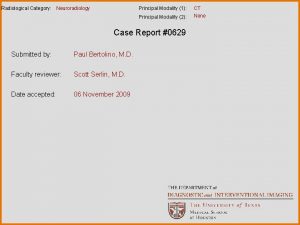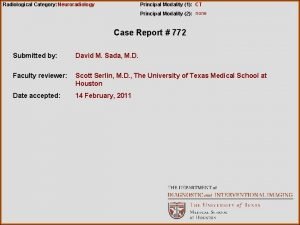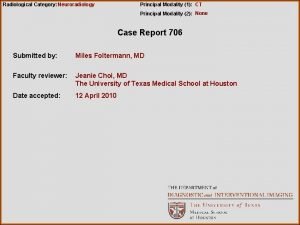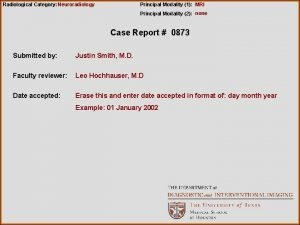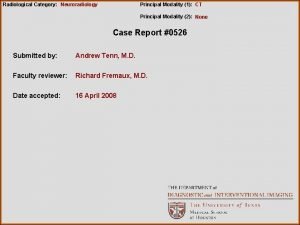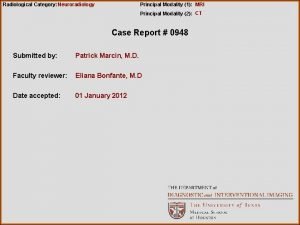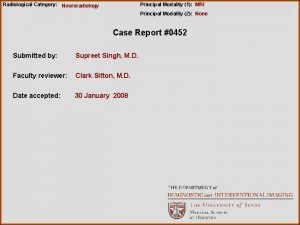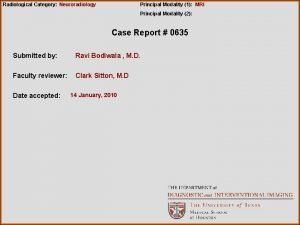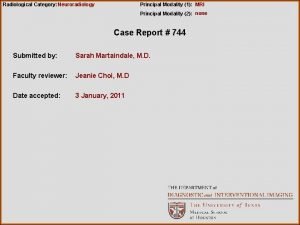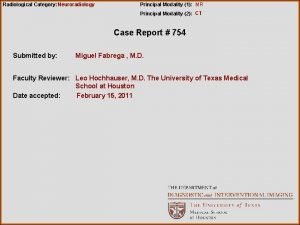Radiological Category Neuroradiology Principal Modality 1 CT Principal












- Slides: 12

Radiological Category: Neuroradiology Principal Modality (1): CT Principal Modality (2): None Case Report #0487 Submitted by: John S. Yoo, M. D. Faculty reviewer: Eliana Bonfante-Mejia, M. D. Date accepted: 14 March 2008

Case History 53 year old male complaining of several months of neck swelling with no relief after a course of antibiotics.

Radiological Presentations

Radiological Presentations

Radiological Presentations

Radiological Presentations

Radiological Presentations

Test Your Diagnosis Which one of the following is your choice for the appropriate diagnosis? After your selection, go to next page. • Sialosis • Sialadenitis with sialolithiasis • Enlarged necrotic lymph node • Kuttner tumor • Submandibular venous vascular malformation.

Findings and Differentials Findings: Markedly enlarged, enhancing left submandibular gland with a large 1. 1 cm stone in Wharton’s duct. Differentials: • Submandibular venous vascular malformation – lobulated, heterogenously enhancing mass. • Sialosis – painless bilateral enlargement of salivary glands, usually the parotid glands. Associated with diabetes, obesity, and alcoholism. • Kuttner tumor – pseudomass of salivary gland associated with calcification.

Discussion • Sialolithiasis occurs most commonly in the submandibular gland. This is thought to be due to a more viscous saliva and superior direction of travel for the secretions of the submandibular gland. • No exact mechanism formation has been elucidated. Possible factors are thought to include epithelial injury in the salivary gland duct, calcium salt precipitation, and salivary stasis. • Calculi are the most common cause of salivary gland inflammation. Additionally mumps, HIV, coxsackie are frequent etiologies. Poor dental hygiene may also contribute to infection. Microabscesses can sometimes develop.

Diagnosis Sialadenitis caused by sialolithiasis.

References • Grossman RI, Yousem DM, Extramucosal Diseases of the Head and Neck. In: Grossman RI, Yousem DM, ed. The Requisites: Neuroradiology. Philadelphia, Mosby, 2003: 700 -703.
 Ohsu neuroradiology
Ohsu neuroradiology Pa erate
Pa erate Radiological dispersal device
Radiological dispersal device Tennessee division of radiological health
Tennessee division of radiological health Center for devices and radiological health
Center for devices and radiological health National radiological emergency preparedness conference
National radiological emergency preparedness conference Sodality vs modality
Sodality vs modality One to many relationship line
One to many relationship line Deontic and epistemic modality exercises
Deontic and epistemic modality exercises Modality erd
Modality erd Cardinality and modality in database
Cardinality and modality in database Modality in software engineering
Modality in software engineering Birads scoring
Birads scoring














